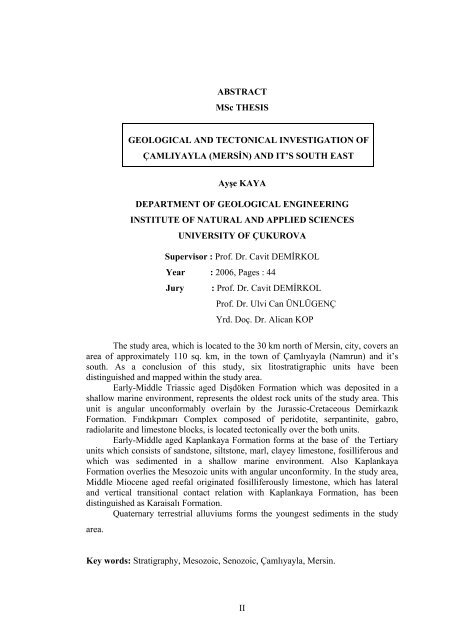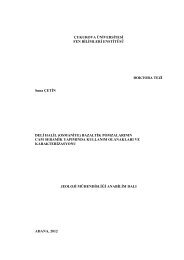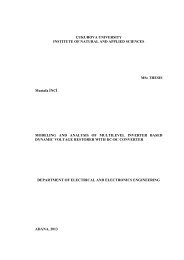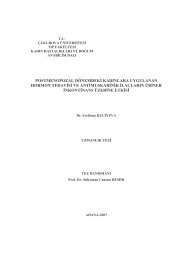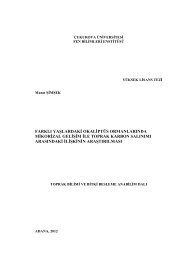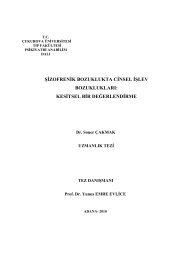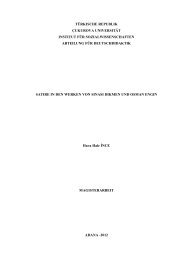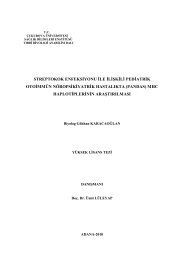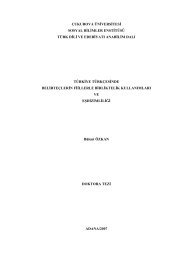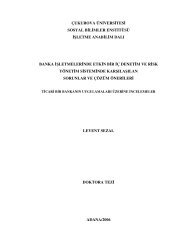ÇUKUROVA ÜNİVERSİTESİ FEN BİLİMLERİ ENSTİTÜSÜ YÜKSEK ...
ÇUKUROVA ÜNİVERSİTESİ FEN BİLİMLERİ ENSTİTÜSÜ YÜKSEK ...
ÇUKUROVA ÜNİVERSİTESİ FEN BİLİMLERİ ENSTİTÜSÜ YÜKSEK ...
Create successful ePaper yourself
Turn your PDF publications into a flip-book with our unique Google optimized e-Paper software.
ABSTRACT<br />
MSc THESIS<br />
GEOLOGICAL AND TECTONICAL INVESTIGATION OF<br />
ÇAMLIYAYLA (MERSİN) AND IT’S SOUTH EAST<br />
Ayşe KAYA<br />
DEPARTMENT OF GEOLOGICAL ENGINEERING<br />
INSTITUTE OF NATURAL AND APPLIED SCIENCES<br />
UNIVERSITY OF <strong>ÇUKUROVA</strong><br />
Supervisor : Prof. Dr. Cavit DEMİRKOL<br />
Year : 2006, Pages : 44<br />
Jury : Prof. Dr. Cavit DEMİRKOL<br />
Prof. Dr. Ulvi Can ÜNLÜGENÇ<br />
Yrd. Doç. Dr. Alican KOP<br />
The study area, which is located to the 30 km north of Mersin, city, covers an<br />
area of approximately 110 sq. km, in the town of Çamlıyayla (Namrun) and it’s<br />
south. As a conclusion of this study, six litostratigraphic units have been<br />
distinguished and mapped within the study area.<br />
Early-Middle Triassic aged Dişdöken Formation which was deposited in a<br />
shallow marine environment, represents the oldest rock units of the study area. This<br />
unit is angular unconformably overlain by the Jurassic-Cretaceous Demirkazık<br />
Formation. Fındıkpınarı Complex composed of peridotite, serpantinite, gabro,<br />
radiolarite and limestone blocks, is located tectonically over the both units.<br />
Early-Middle aged Kaplankaya Formation forms at the base of the Tertiary<br />
units which consists of sandstone, siltstone, marl, clayey limestone, fosilliferous and<br />
which was sedimented in a shallow marine environment. Also Kaplankaya<br />
Formation overlies the Mesozoic units with angular unconformity. In the study area,<br />
Middle Miocene aged reefal originated fosilliferously limestone, which has lateral<br />
and vertical transitional contact relation with Kaplankaya Formation, has been<br />
distinguished as Karaisalı Formation.<br />
Quaternary terrestrial alluviums forms the youngest sediments in the study<br />
area.<br />
Key words: Stratigraphy, Mesozoic, Senozoic, Çamlıyayla, Mersin.<br />
II


